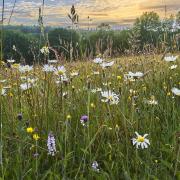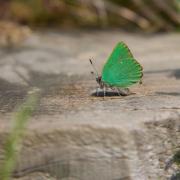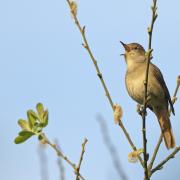The on form exhibition will be online having run every two years since 2000
To view the on form exhibition and to buy featured pieces, visit onformsculpture.co.uk
Twenty years ago, Rosie Pearson had the idea of staging an exhibition of sculpture in the grounds of her home, beautiful Asthall Manor in the Oxfordshire countryside. Over the years it has grown, achieving international acclaim and drawing over 10,000 visitors in the month it’s open. This year was to be the tenth exhibition, featuring 36 exceptional sculptors in stone but, as with all other events at this time, Covid19 has put a virus-shaped spanner in the works. Not to be defeated, however, Rosie and co-curator Anna Greenacre have taken on form online, with the hope of throwing open the gates to Asthall later in the year
2000 Anthony Turner visited me on his way to installing a commission in the North of England. In the back of his van was a sculpture called Pumple, short for Pumplestiltskin. I had been pondering what to put on my new gateposts, and decided I needed something like this – a mysterious form that was both welcoming and indefinable.
2002 The first exhibition took place. People came flocking to see the new Bannerman garden, and the house where the Mitfords grew up, which had never been open before. Some of them were surprised to find that they quite liked the sculpture too. The two pieces I have chosen to represent this year are both somewhat creaturely; they have character and humour, as if they might come alive when you’re not looking. They are Remorse by Nigel Watson and Two Elements by Luke Dickinson.
2004 We decided to limit the exhibition to work in stone. I was impressed with the particular dedication of the stone carving community, and felt that stone deserved a place of its own. Master sculptor, Peter Randall-Page, took part for the first time. The picture shows his viscerally powerful sculpture, Mother Tongue, with me and my mother, the only time she ever visited the exhibition, as she had a debilitating stroke shortly afterwards. We only had 40 sculptures in 2004.
2006 Was the first year in which I collaborated with Anna Greenacre as curator, enabling the exhibition to deepen in seriousness and range. The three sculptures illustrated show the resonant simplicity of Anthony Turner’s Mangosprout, placed under our Weeping Ash, the edgy bonded granite Column by Richard Aumonier, and the power and beauty of Man Mountain by Paul Vanstone. We had 52 sculptures in all.
2008 is represented by Dominic Welch’s fabulous Cetacean Plume, which was on the front lawn, and the work of Emily Young, shown here installing her bi-disc in a silver birch by the swimming pool. I’ve also included a photograph of Bridget McCrum’s Mythical Horses, taken after the exhibition was over, showing how the family, including the pets, make the sculpture their own when the gates are closed. 56 sculptures.
2010 We saw two newcomers to on form working with light: Simon Hitchens, whose mirrored works reflected the garden back to the sculpture, as well as exploring the relationships within the rocks, and Rachel Schwalm, whose lenses placed within her sculpture turned the Windrush Valley upside down. We also had our largest ever work this year: Peter Randall-Page’s Corpus, fresh from the Yorkshire Sculpture Park, which weighed 14 tonnes. We had 72 outdoor sculptures.
2012 We had the phenomenal Crack by Julian Rena at the front of the house, opposite a red blood cell by David Worthington. This year, we introduced two newcomers who have since become on form favourites: Jordi Raga, represented here by the delicate Souvenir from hereafter, and Guy Stevens, whose Vortex is seen here against a Windrush Valley sunrise. This year, our numbers shot up to 169, but this was partly accounted for by the fact that we numbered our indoor sculptures for the first time. This was the first year that we put sculpture in St Nicholas’s Church, and also the first year of the Potting Shed café
2014 the firsts continued, and it is very hard to choose from amongst the extraordinary range of work. Many visitors will remember Campionessa, pictured with her creator Matthew Spender. We put work in the swimming pool for the first time – Aly Brown’s Parvati is shown here, and Guy Stevens managed to create stones which actually floated, on both the swimming pool and the lake. We had Mel Fraser’s callipygian Venus welcoming visitors at the front of the house and, for something completely different, the Polish sculptor Szymon Oltarzewski’s wildly eccentric and delicate forms (shown here is Blow) were set off by the cow parsley in the orchard. 204 sculptures. This was the first year of the Madhatter Bookshop in the pool pavilion, and our happiest story was from Salusbury World, a charity whose mission is to support and empower refugee and migrant children, young people and families, who told us that two friends who had last seen each other in Syria met in our car park!
2016 We made some huge changes. For the first time, we furnished the ballroom (in collaboration with Lorfords antiques) so that visitors could be inspired by the idea of living with sculpture. We also moved beyond the boundary of the garden into the meadow ,creating a winding path to the Windrush River. Here, Mark Stonestreet’s Fragment is being lowered into place with the help of farmer Philip Walker’s telehandler. We had 268 sculptures this year.
2018 The front of the house was dominated by Jon Isherwood’s Singer of Tales, one of those sculptures that everybody saw a different way. Here, it is being experienced by a group from the Oxfordshire Association for the Blind, who talked about how important it was to them to touch the sculpture. Just on the other side of the front path were Vanessa Paschakarnis’s extraordinary Capricornos – another work that insisted on human engagement.
2020 Our tenth exhibition, we had exciting plans, which all focussed on deepening the on form experience, rather than growing bigger. Instead, like countless other enterprises, we have had to put our exhibition online. It has been a good time for reflection, sorting out old photographs, and thinking about what really matters. The photograph illustrates my daily work this spring – editing the website, inspired by the small pieces of desk sculpture which have been given to me by artists over the years..



























